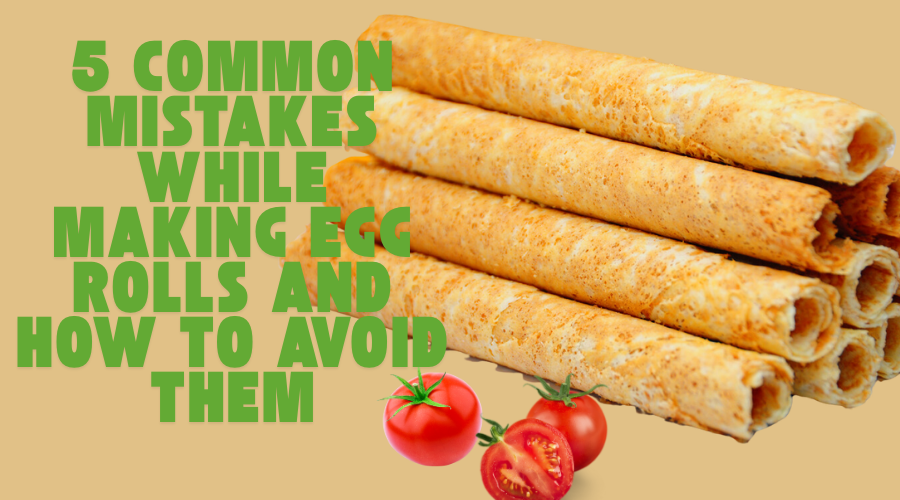
Oct 31,2024
There's just something so darn appealing about the egg roll- the satisfying crunch upon biting into that crispy wrapper, then the explosive burst of savory flavors from the perfectly seasoned filling. While these Asian-inspired appetizers are a favorite takeout, making them at home may be a rewarding experience. However, the balance of that perfect restaurant-quality crunchy outside and flavorful inside eludes many home cooks. In the article below, we reveal the five most common mistakes people make while preparing an egg roll and devise practical solutions to solve each of these problems so that you, too, can make these yummy treats like a pro.
One of the biggest mistakes, which is admittedly also one of the most tempting, is filling too much into each wrapper. We get it- you want every bite filled with those flavorsome ingredients. However, overfilling is a recipe for disaster. Too much filling will make the wrapper stretched and tense. As such, it is easy to tear when you roll and fry it. Also, an overfilled egg roll can never cook right; it may appear crispy outside but undercooked inside.
So, it would help if you tried not to make that mistake by using less filling like only 1 to 2 tablespoons of filling for each wrapper. While this may feel very minimalist, the exact amount will give you a perfectly balanced egg roll. Place the filling primarily in the middle of the wrapper, allowing much room for rolling. And remember, make sure the filling is compact and equally distributed. This measured approach helps ensure that your egg rolls cook uniformly and maintain their shape during frying.
Your choice of oil and usage can easily make or break your egg rolls. Similarly, using oils with low smoke points, such as unrefined oils or olive oil, which are typically used for frying, leads to unwanted flavors and even the creation of harmful compounds when heated to high temperatures. Too much oil, however, results in greasy and heavy egg rolls that nobody wants to eat.
The solution is to use a flavorless oil that can stand a high temperature, such as vegetable oil, canola oil, or peanut oil. These oils will hold up well to the heat the egg rolls require for crispiness without breaking down and giving flavor. When frying, add just enough oil to bring halfway up the sides of the egg rolls-about 2-3 inches in your pan. This keeps them from getting too greasy and cooks them evenly.
Poor sealing is a common problem that usually makes the otherwise fun egg roll-making session frustrating. If not appropriately sealed, such wrappers may burst open during frying-they let the filling out and the oil in. Not only does it make your egg rolls look ugly, but it also deteriorates their texture and taste.
To seal well, prepare a small bowl of water or beaten egg in advance. When you reach the final corner of the wrapper, dab some water or egg wash along the edges. Complete the roll by applying gentle yet firm pressure to make sure all the edges are sealed well. Think of it like closing a letter envelope—you want to have a tight package that does not open during cooking.
Frying egg rolls is mainly about the temperature; if not hot enough, they'll drink up the oil and get soggy and too hot, and they'll burn on the outside while undercooked on the inside. If not appropriately watched, it is a delicate balancing act.

The key to better texture is maintain the oil temperature between 350-375°F. Get a good kitchen thermometer; believe me, it pays off in perfect results every time. You don't need a thermometer: test the oil temperature by throwing in a piece of wrapper high, which should sizzle and pop up to the surface with no burning. Also, remember to fry in batches to keep the oil temperature up and adjust your heat accordingly as you go along.
Sometimes, even the best-fried egg rolls are ruined simply because they weren't drained very well. If fried foods aren't drained properly, excess oil weighs them down and makes them oily instead of crispy.
Before you start frying, set up a proper draining station by placing a wire cooling rack over a rimmed baking sheet or by laying out several layers of paper towels. When the egg rolls come out of the oil, hold them above the pan for a second or two to let the excess oil drip off, then place them on your draining setup. Line the egg rolls up so that they are not touching each other to allow air to circulate and keep them crispy.
Having perfect homemade egg rolls is all about steering clear of some of the common blunders. Keep in mind what to avoid:
With practice, you will be churning out rolls that will impress family and friends and rediscover the quality of the better restaurants.
Q: Can these be prepared and rolled in advance, stored covered in the refrigerator for 24 hours before frying?
A: Yes, you can prepare and roll them for after use, store them covered in the refrigerator for up to 24 hours, and fry them just before serving.
Q: Why are my egg rolls greasy?
A: Greasy egg rolls are usually caused by too cool or improperly draining oil. Keep the oil temperature right and drain well after frying.
Q: Can homemade egg rolls be frozen?
A: You can freeze uncooked egg rolls for only three months. Please place them in a single layer, freeze them until solid, and then move them to a freezer bag. Fry straight from frozen, adding a few extra minutes to the cooking time.